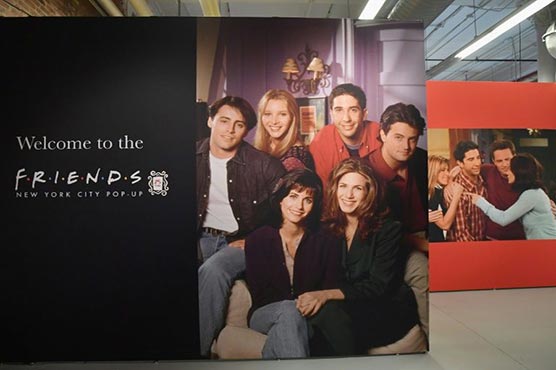The big business of classic TV for streaming giants

If you are a streaming powerhouse, the answer is: quite a few.
NEW YORK (AFP) - How many hundreds of millions of dollars would you pay for reruns of "Friends," the American version of "The Office" or "The Big Bang Theory"?
If you are a streaming powerhouse, the answer is: quite a few.
As online video platforms jockey for position with new rivals for audience share, classic television series are commanding hefty sums.
"It’s a feeding frenzy right now," says Dominic Caristi, a professor of communications at Ball State University.
In 2018, Netflix produced 140 original programs, but the most-watched series was "The Office," made by traditional network NBC and which ended its successful run six years ago.
According to ratings tracker Nielsen, "The Office" is followed by "Friends" and far outpaces any of the streaming giant’s own offerings.
But in 2021, Netflix will have to surrender the rights to the offbeat musings of Dunder Mifflin manager Michael Scott (Steve Carell) and his team, when the show moves over to NBCUniversal’s video platform in a deal that will cost about $500 million over five years.
From 2020, Netflix also must give up "Friends," which will move over to WarnerMedia’s HBO Max platform -- at a steep price of $425 million for five years.
And reports say HBO Max is looking to acquire the rights to both "The Big Bang Theory" and "Two and a Half Men" for an eye-popping $1.5 billion.
When Netflix entered the streaming game in 2010, networks and production studios generally maintained a policy of using the platform as the third option after a show’s original broadcast run and a life of reruns in syndication. It was an easy way to monetize their investments.
But with nearly 160 million subscribers worldwide, Netflix is now a direct threat to the television industry’s traditional power players, who are now launching their counter-attacks.
"People want an experience that they can share," Caristi notes.
"In the golden years of television, we always talked about ‘water cooler’ shows -- the programs that people at work the next day would talk about," he explains.
"The shows that have been here longer like ‘Friends’ have a cumulative audience -- people who saw them in the ‘90s when it first aired, the ones who saw the reruns, the people who are watching them now. And so they’re able to share that experience with more people."
Exclusivity
Starting in November, Apple and Disney will launch their own TV ventures. WarnerMedia and NBCUniversal will follow suit over the next year.
They’ve all spent billions of dollars to acquire and produce content that will draw in subscribers and rival Netflix’s vast offering.
"Sharing destination assets like that is not a good model to share -- my belief is that they should be exclusive," Kevin Reilly, who is running HBO Max for WarnerMedia, said in February about buying the rights to show "Friends."
Disney is adopting the same strategy for Disney+, where it will show all the Marvel superhero films, Pixar animated classics and "Star Wars" movies. Until now, some were accessible on other platforms.
The need to laugh
The industry changes mark a fundamental shift in the trajectories of these classic television series, whose second lives as rerun staples on cable networks and Netflix have somewhat lessened their value.
"I think Netflix is going to feel the effect," Caristi says. "They’ll still be the number one, at least for a while, but they’ll lose some market share."
No one thinks classic series from the ‘90s are enough on their own to draw in subscribers for the new platforms, but for Caristi, they help streaming services "make sure that there’s enough content you’re interested in."
In this calculus, nothing is as golden as a sitcom -- not even the behemoths of the latest peak TV era like "Breaking Bad" or "Mad Men."
"You don’t have to watch them in sequence. You don’t have to know a lot about the characters. You can come to the program wherever and watch a random episode," Caristi says of the enduring appeal of half-hour comedies.
Getting involved
In a strange twist, streaming services are willing to pay hundreds of millions of dollars for old sitcoms -- but not willing to shell out the same amount to make their own.
In 2020, none of the main streaming players offering original content are producing old-school sitcoms recorded before a live studio audience.
"Nobody seems to know how to make comedy anymore," observes Michael Lembeck, who has directed dozens of sitcom episodes, and notably worked on "Friends."
Today’s television comedies are "provocative, they are alternative and you watch them disconnected. You don’t get involved with them," he said, while people "love to get involved" with the old-school shows.
For Dana Coen, a screenwriter and professor at the University of North Carolina at Chapel Hill, streaming platforms have perhaps been hesitant to make comedies "because of the nature of streaming itself, which is designed to present viewers with stories that develop steadily in the way a feature film does."
Industry observers agree that no matter the rise of streaming’s influence, sitcoms will endure.
"Like much else in this industry, once a producer is able to present a breakout sitcom on a streaming service, the others will follow," Coen says.
James Michael Tyler, who played the long-suffering barista Gunther on "Friends," noted: "People want to laugh. Even more now these days. You need that."

